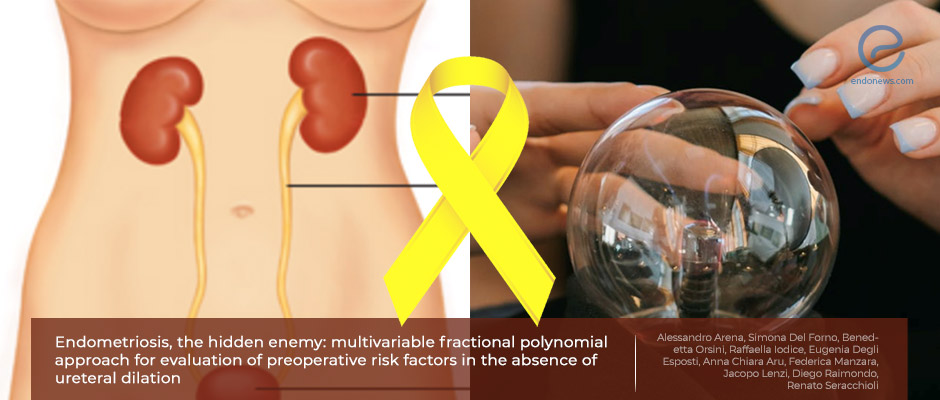Evaluation of preoperative risk factors of ureteral endometriosis
Jun 15, 2021
The predictability of ureteral involvement of endometriosis in the absence of ureteral dilatation does matter.
Key Points
Importance:
- "Ureteral involvement" of endometriosis in deep infiltrating endometriosis is easy to suspect when dilatation of the urethra is present. In cases without signs of ureteral stenosis, it is hard to decide even using the second level techniques such as MRI or computed tomography.
Highlights:
- A posterior deep infiltrating endometriosis nodule with a transverse diameter of more than 1,8 cm. is associated with a higher probability of ureteral endometriosis.
What's done here:
- A prospective observational study was set up to reveal if there is a "ureteral involvement" of endometriosis in the absence of ureteral dilatation in deeply infiltrating disease.
- Arena et al. evaluated 300 women with a preoperative diagnosis of deeply infiltrated endometriosis scheduled for laparoscopy in their tertiary center.
- A multivariable fractional polynomial approach was used to determine and predict the "ureteral involvement" without a specific urinary complaint or a clear sign of ureteral endometriosis by transvaginal ultrasonography.
Key results:
- Among these 300 women with histologically diagnosed endometriosis, 195 also had a diagnosis of adenomyosis.
- After the laparoscopy, ureteral endometriosis was confirmed in 145, and 105 (75.2%) histologically diagnosed with adenomyosis in this group.
- Patients with adenomyosis have a two-fold higher risk of ureteral endometriosis and those with parametrial involvement have a fourfold higher risk of ureteral endometriosis.
- Good predictors of ureteral endometriosis were:
- Posterior deep infiltrating endometriosis nodule diameter bigger than 1,8 cm
- Presence of adenomyosis and endometriosis parametrial invasion, and
- Previous surgery for endometriosis.
Strength and Limitations:
- The study being a single center experience, absence of additional diagnostic techniques such as MRI or CT may be the limitations.
- The prospective nature, being performed in a referral academic center, the strength of the mathematical model and surgical-pathological confirmation of all cases are the strengths of the study.
Lay Summary
Endometriosis affects the urinary tract in 1% to 5.5% of the patients, and among them, bladder involvement is 70-85%, while ureteral involvement alone is 9% to 23%.
Ureteral endometriosis is most commonly unilateral, especially on the left side, usually affecting the distal part. Some patients with ureteral endometriosis don't complain of any related symptoms even though it can cause dysuria, dyspareunia, and chronic pelvic pain. Moreover, there are no standard imaging methods for preoperatively evaluating the presence of ureteral endometriosis. Preoperative assessment of ureteral endometriosis will help the surgeon to plan a correct surgical approach and minimize disease recurrence and complications.
The aim of this study is to evaluate the predictors of ureteral endometriosis using a mathematical model based on preoperative findings and to determine the suitably functional form for surgeons who are planning to operate deeply infiltrating endometriosis patients. Arena et al. from the Department of Gynecology and Human Reproductive Physiopathology, University of Bologne, Italy, evaluated 300 women diagnosed with posterior deep infiltrating endometriosis scheduled for laparoscopy in their tertiary center. The history of endometriosis, related symptoms, and the severity of their complaints assessed by a numerical scale. The anatomical location of endometriotic lesions was described using "International Deep Endometriosis Analyses" and adenomyosis was diagnosed by transvaginal ultrasonography using Morphological Uterus Sonographic Assessment (MUSA).
After the surgery, endometriosis was confirmed in all 300 patients, 145 diagnosed with ureteral endometriosis, and adenomyosis was encountered in 195 women of which 105 had ureteral endometriosis. The authors used the "multivariable fractional polynomial technique" to select to predicting risk factors of ureteral endometriosis.
The definitive diagnosis of ureteral endometriosis is still based on surgical and histopathological investigations. According to the results of the current study published in the scientific journal "Fertility and Sterility", the presence of posterior deep infiltrating endometriosis nodules bigger than 1.8 cm, adenomyosis, parametrial infiltration, and previous surgery for endometriosis are important predictors for preoperatively predicting ureteral endometriosis.
Research Source: https://pubmed.ncbi.nlm.nih.gov/33962769/
deep infiltrated endometriosis adenomyosis vaginal ultrasonography laparoscopy multivariable fractional polynomial ureteral endometriosis.

